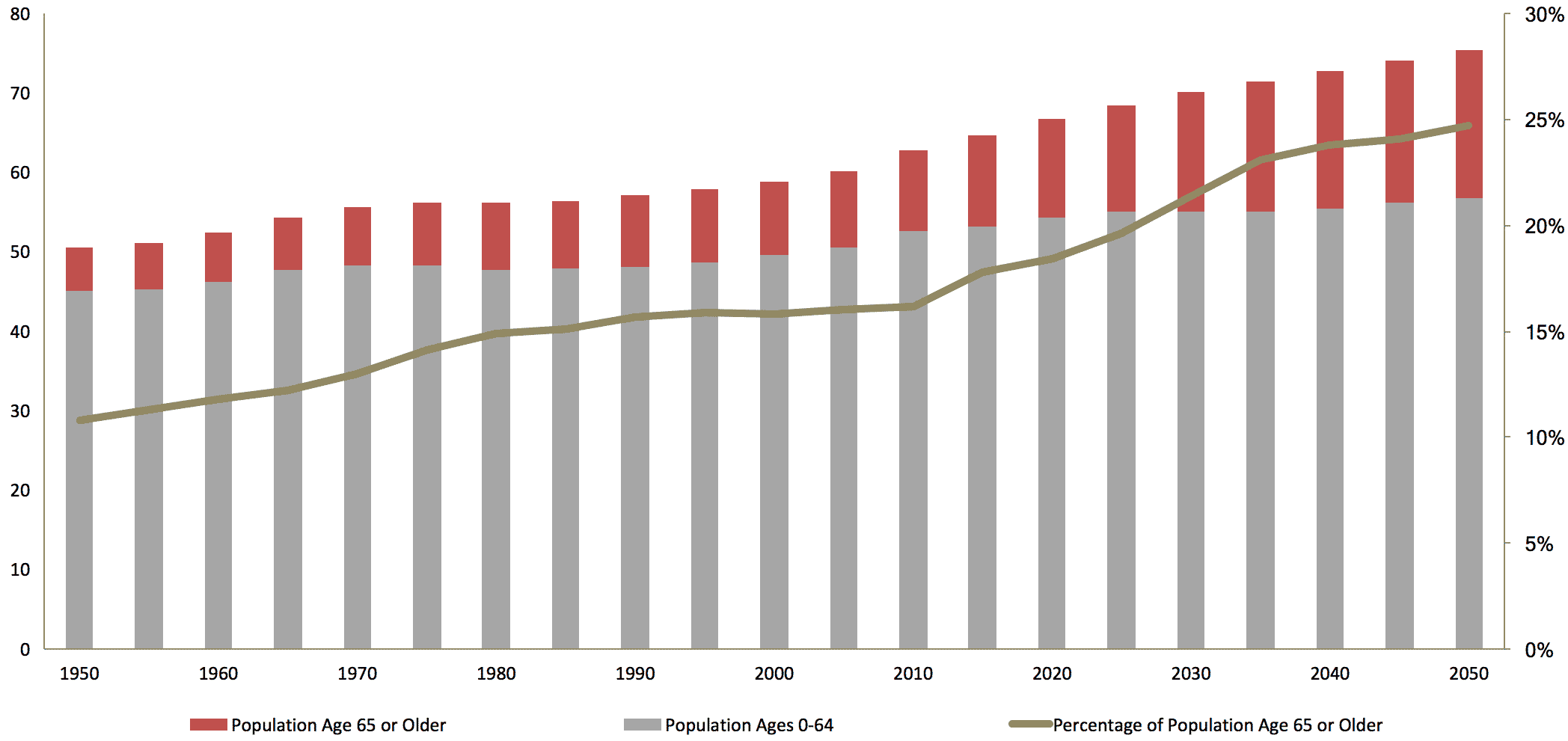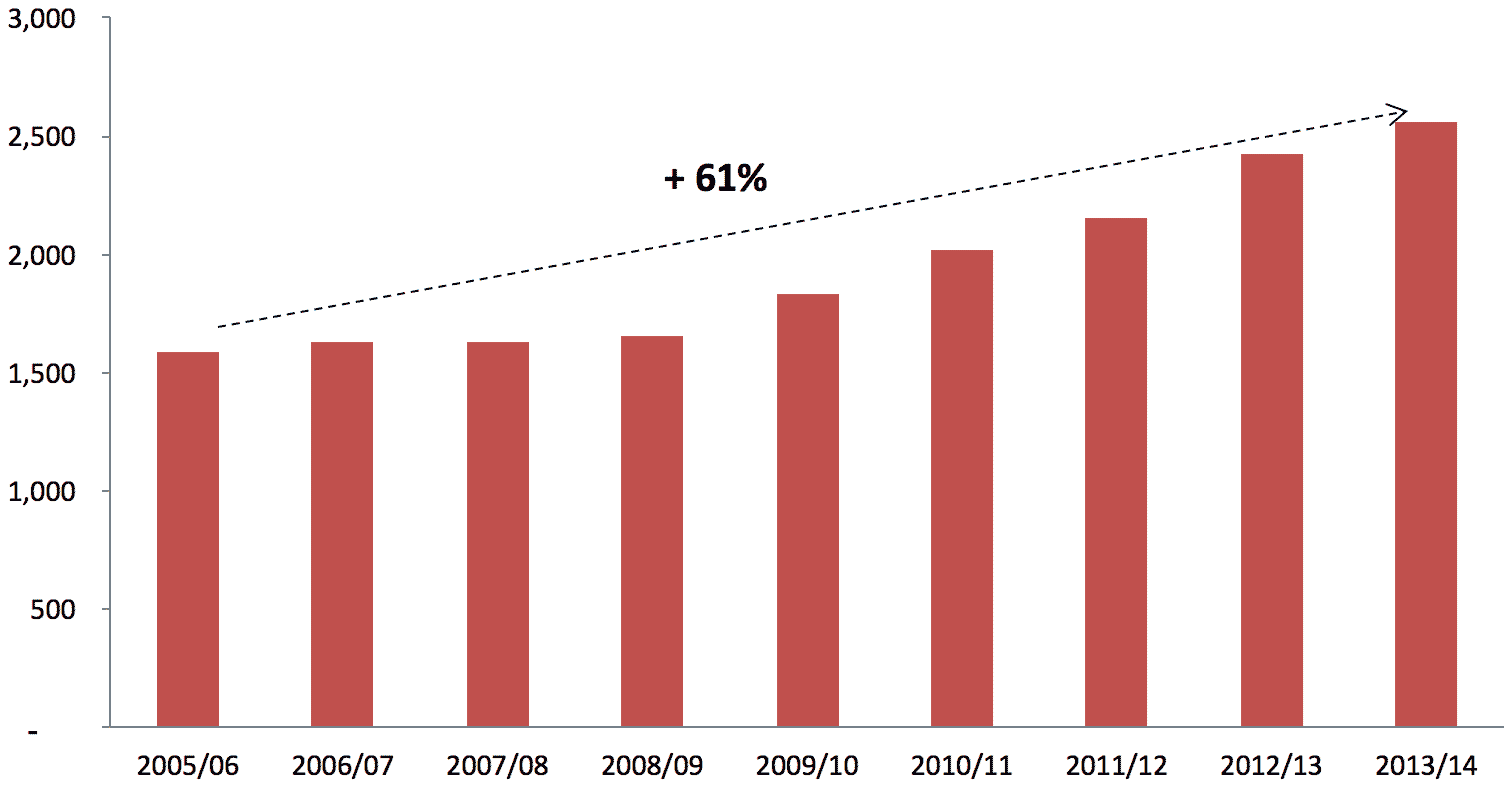Like many European countries, the UK has been an aged society for several decades, but as baby boomers are growing older, the country will see the pace of aging accelerate over the next two decades. The population of older adults is projected to grow by nearly 45 percent from 2015 through 2035, growing by 278,000 each year, almost ten times the average annual increase in the working population (15 through 64 years old).
As a result, there will be tremendous economic potential found in older people, if it can be harnessed through continued employment or other productive activity. While the UK already has higher labor participation by older adults than other major European economies, the government has been seeking new avenues to increase productive opportunities. Major efforts include fostering a more age-friendly labor market in addition and generating incentives through the pension and benefit system reforms.
Public funding cuts in recent years represent a major challenge to the UK’s long-term care system and social service delivery. While the government has made minor adjustments to tax policy, caps on local revenue generation continue to constrain the ability to fund services. Devolution of funding and service delivery to local governments also creates challenges for older adult programs and service delivery. Varying government bureaucracies and strategic priorities across the UK, from England, Wales, Northern Ireland, and Scotland, also result in service fragmentation and uneven impacts of otherwise effective programs.
Population by Age Group (in Millions) and Percentage of Population Age 65 or Older

The UK’s older population is projected to grow by over a quarter of a million people each year through 2037, nearly 10 times the average annual increase in the working population.
Sources: UN Population Division, ILC-UK

Community Social Infrastructure
While the British government recognized the importance of social inclusion with a task force dedicated to this issue, this group was abolished in 2010, and the policy area is no longer an explicit focus. NGOs and the private sector have attempted to fill the gap by developing innovative approaches to enhance social inclusion, transportation access, and suitable housing stock. Funding remains a challenge in areas such as transportation, housing retrofits, and winter heating subsidies, but increasing local governments’ ability to raise needed revenue, collaborations between the public and private sectors to foster innovative design, and utilization of technology and digital inclusion are a few of the areas that are being explored to improve the quality of life for older adults in the UK. Many services targeting older adults have devolved from the central government to local authorities, and successive British governments have provided initial funding for programs to “prime the pump” and help create an enabling environment for local governments and organizations to deliver services independently.
“Increasing the ability of local authorities to provide transportation services will be critical to enabling older adults to continue to contribute to the economy while they are active, as well as to tackling the issue of social exclusion.”
– Roger Mackett, Emeritus Professor of Transport Studies at University College London
The importance of the concessionary bus pass service to the older population is illustrated in ridership, with total concessionary journeys (elderly or disabled, and youth concessions) making up 34 percent of all bus passenger journeys in England in 2016, representing 1.53 billion rides.
Re-conceptualizing Aging in Place − Better Living Through Design
Adaptation of the existing housing stock for older adults could create homes as places of work, community, and care by moving beyond narrow and traditional considerations of housing to develop integrated designs for living that carefully consider the various needs of older adults. The recent New Old exhibition in London, which opened in January 2017, seeks to rethink some of these key issues and offers forward-thinking ideas as to how design can help overcome challenges related to aging, identity, home, community, work, and mobility. Novel ideas, such as those for connected, multi-unit housing with back corridors that allow for companies to deliver groceries and household goods directly, offer concepts for consideration and potential public and private collaboration. The models and ideas put forth are conceptual at this stage but intended to inform future design and investments.
Productive Opportunity
Recognizing the economic potential of their aging population, the British government has sought to foster more age-friendly labor markets. In addition to reforming the pension and public benefit system to provide incentives to stay in the labor force, a range of other policies have been pursued with this objective in mind, including those that provide assistance to help older adults go back to work. However, research by Age UK has shown poor outcomes for many older workers who face a range of challenges such as hourly cutbacks, insecure employment, and difficulty transitioning in the tech-based economy. While the labor-participation rate is increasing, there remains notable age discrimination in the workplace in spite of legislative programs over many years attempting to address it.
According to ILC-UK, of the 3.3 million economically inactive adults aged 50 through 64, approximately one million have been made “involuntarily workless” after being pushed out by a range of factors, highlighting the lost productive opportunity and the need for more support for older adults in the workplace.
Promoting Entrepreneurship – the New Enterprise Allowance
The New Enterprise Allowance (NEA), launched in 2011, aims to help unemployed, low-income, or disabled individuals (18 years old and above) start their own businesses. Under the NEA scheme, those who are eligible are matched with a volunteer business mentor, who assists them in drawing up a business plan. Once the plan is approved, the applicant has access to further support, including mentoring for the first six months, a tax-free weekly allowance, and loans for start-up costs). By September of 2016, 175,370 individuals had received access to a business mentor, and 95,320 individuals had started a business under the NEA scheme. The NEA benefits older adults and people age 50 or older who are often on the margins of the labor force. More than 22 percent of beneficiaries of the NEA scheme are older people: around 38,300 individuals age 50 and older have received assistance, and nearly 22,300 of them have started their own business. It also assists informal caregivers in starting their own new business, enabling them to work on flexible schedules while taking care of their older family members.

Technological Engagement
The penetration of digital technologies in the UK’s general and older population is among the highest in Europe, and the British government continues to seek additional avenues to improve digital inclusion. Still, several studies have identified multiple barriers that continue to inhibit digital inclusion, from insufficient infrastructure to the users themselves. The government released its updated digital strategy in March of 2017, which prioritizes continued investment in digital infrastructure and promoting digital skill development, including access to free training. The government recognizes that cross-sector engagement will be necessary, and the UK Secretary of State for Culture, responsible for technology, will be establishing a forum to engage stakeholders to move the strategy forward. There is considerable economic potential that could be realized with greater digital inclusion among older adults. A recent study estimated that full digital take-up could add GBP 63 billion (approximately USD 81 billion) in value to the economy.
Percentage of Population Ages 55-74 Using the Technology in the Last Three Months

As of 2014, 72 percent of people ages 65 through 74 in the UK were Internet users, well above the OECD average of 50 percent.
Inclusive Design Expanding Technology Access for Older Adults
AbilityNet, an NGO, is consulting with major international technology companies, such as Microsoft, to help them develop user-friendly technologies and practical solutions that apply to the aging and the disabled, but are also designed for every mobile user. This type of inclusive design impacts all users, expanding the market and strengthening the business case for technology developers.
“Technology is the biggest leveler, and simple, basic changes on computers and devices can be made to significantly ease use and enhance quality of life…The mere enforcement of accessibility standards currently on the books would change the landscape beyond recognition.”
– Robin Christopherson, Head of Digital Inclusion at AbilityNet
Healthcare & Wellness
Technology also holds promise to help address one of the UK’s greatest challenges: the increase in healthcare and long-term care demand alongside declining budget allocations and increased austerity. These dynamics are putting pressure on older adults and informal caregivers. In response, the government is increasing funding transfers and allowing for local tax hikes to help fill the growing gaps in funding for local governments. Recognizing that much more will be needed, in 2016, the British government launched a major technology initiative aimed at leveraging technology to help cut costs and balance budgets in the face of an aging population. Related initiatives are just getting off the ground but hold promise for public-private collaborations between the National Health Service (NHS) and industry to develop and deploy technologies that will help reduce costs and enable older adults to age in place longer and more comfortably.
The number of informal caregivers hit 17.6 percent of the total population in 2014. That year, 20.5 percent of older people provided unpaid care, taking on a higher share of the caregiving burden, particularly unpaid caregiving.
Average Annual Out-of-pocket LTC Expenditure

Public spending on older adults’ LTC has declined over the past five years by around 10 percent, while out-of-pocket expenses have soared by 55 percent.
NHS and Industry Advance “Innovation Test Beds”
In January of 2016, the NHS announced the launch of seven “Innovation Test Beds,” which are a collaboration between the NHS and industry to focus on a range of issues, including diabetes, heart disease, mental health, and older-age care. Select test beds will evaluate advanced technologies to help in addressing dementia, provide medicine reminders, and help enable older adults to reside at home longer. One primary aim of the innovation centers is to help keep older adults out of costly and congested hospital settings and to provide cost-effective solutions that help enable adults to live longer and more comfortably at home.